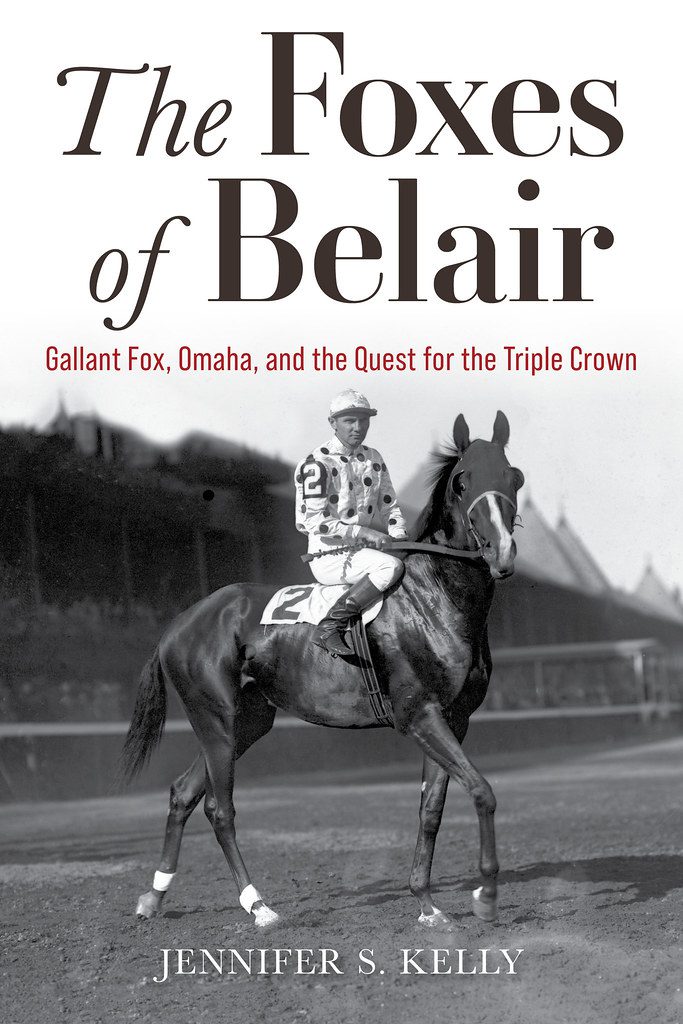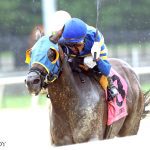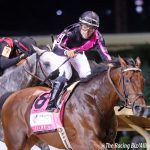“The Foxes of Belair” excerpt: The Fox Comes Around
“Sunny Jim” Fitzsimmons had arrived in Baltimore on Thursday, May 8 to saddle the Belair horse for the big race the next day. Along with the famed trainer, William Woodward was on hand for Friday’s big test, joining Ral Parr, owner of the 1920 Kentucky Derby winner Paul Jones, and others in Vice-President Charles Curtis’s box. Also present at Pimlico was a special guest of the Maryland Jockey Club, eighty-year-old George Barbee, the jockey who had ridden Survivor to victory in the first Preakness Stakes in 1873 (1). In all nearly forty thousand people jammed into Pimlico Race Course for the day’s racing, a beautiful May day greeting the crowd. A band on the brick lawn played a variety of tunes, including “Maryland, My Maryland,” playing the tune when Governor Albert Ritchie climbed the steps to the judges’ stand to watch the race and then present the Woodlawn Vase to the winning owner (2). With the sun growing lower in the sky, starter Jim Milton presided over the parade of horses milling behind something new for the 1930 Preakness Stakes, a starting gate.
The Bahr starting gate, another version of the technological innovation that was still gaining ground at the country’s racetracks, resembled the starting gates modern fans know with its metal frame and individual padded stalls for horses. However, the gate’s stalls did not have barriers on the front or the back to keep horses in; instead, the familiar cabled barrier was strung across the front of the gate, lifting at the starter’s push of the button. As the barrier went up, the gate’s bell would ring, signaling the start of the race (3). Pimlico had started using the Bahr gate in 1929, but others would adopt different versions of the starting gate in the early 1930s (4). What the gate did not do was prevent horses from acting up as they waited for the start and the 1930 Preakness had its bad actor in Armageddon. This son of Man o’ War held up the start long enough that Milton sent him to stand at the end of the gate, rather than in a stall, for the start (5). Gallant Fox too fell out of line a couple of times, but Milton finally got the field to stand in line long enough to send them away. Sure enough, Tetrarchal jetted to the lead, crossing to the rail and cutting off the horses behind him, including Gallant Fox. Crack Brigade moved into second with Sweet Sentiment and Gold Brook behind him. Gallant Fox found himself boxed in on the first turn, sitting far back in eighth position. [Jockey Earl] Sande realized, though, that staying in that position would mean trouble later. Taking Gallant Fox to the outside was the only way to go (6).
On the backstretch, Sande took his horse out from the rail, going around horses rather than staying boxed in on the rail and waiting for an opening. Even though he had lost ground moving out toward the middle of the track, that path on the straightaway gave him space to accelerate (7). Gallant Fox picked up his pace, moving from eighth at the half-mile call to third at six furlongs, with three and a half furlongs to go. That meant Sande needed Gallant Fox to make another move after a breather on the far turn. A tiring Tetrarchal started to fade, surrendering to Crack Brigade, who assumed the lead with only a furlong and a half to go (8). Gallant Fox accelerated again, running even with Crack Brigade for a few yards before Sande tapped him with the whip twice. The jockey told Woodward later that the Fox had not wanted to pass Crack Brigade, given his fondness for running in company and all, so he had to use the whip to remind the colt to pass his competitor. Gallant Fox pulled away to win by a length, a brilliant performance that Sande summed up with “He is a great horse, Mr. Woodward.” (9)

In the winner’s circle, Governor Ritchie gave a grinning William Woodward the prized Woodlawn vase, presented annually to the winner of the Preakness Stakes. Earl Sande had his photo made with George Barbee and showered praise on the colt that brought him what would be his only Preakness Stakes. Team Gallant Fox was jubilant after a hard-fought victory, but the evening was not done until the question had been asked: Would Gallant Fox start in the Kentucky Derby and would Earl Sande be riding him?
“Sunny Jim” passed the day receiving congratulations from friends, a watchful eye on his horse as he cooled out from the tough trip. With Gallant Fox back in his stall, Woodward returned to the barn to find Fitzsimmons already arranging to send his Preakness winner on to Louisville for the Kentucky Derby. The master of Belair insisted on shipping the Fox with his workmate Rattler, a pony, a dog, six men, and Fitzsimmons’s friend and long-time farrier Bill Dallimore on Sunday afternoon.
Before leaving Pimlico, William Woodward visited Earl Sande in the track’s jockey quarters, seeking out the blonde rider who had been on some of the era’s best horses – Man o’ War, Zev, Sir Barton – to inquire about riding Gallant Fox again. Sande had originally agreed to only two races and those two had come and gone. Woodward offered the famed jockey $10,000 to ride Gallant Fox in 1930, but Sande wanted different terms, agreeing to a 10% share of the colt’s winnings (10).
“We’re going to win a lot of races,” Sande said, presaging the ride that the Fox was about to take the three of them on over the course of this extraordinary season.
WHERE TO BUY “THE FOXES OF BELAIR”? CLICK HERE FOR YOUR OPTIONS!
[1] Reber, Ben J., “Earl Sande Rides Gallant Fox to Victory in Preakness,” Atlanta Constitution (Atlanta, GA), May 10, 1930. [2] Runyon, Damon, “Sande Rides Gallant Fox to Preakness Victory,” Evansville Courier (Evansville, IN),May 10, 1930. [3] “Stall Gate a Success, This Perfect Start Shows,” St. Louis Post-Dispatch, November 17, 1929. [4] “Buckeye Poet First in Stake Contest at Pimlico Track,” The Gazette (Montreal, Quebec), November 13, 1929. [5] “Preakness to Gallant Fox,” Daily Racing Form, May 10, 1930. [6] “Preakness to Gallant Fox,” Daily Racing Form, May 10, 1930. [7] Woodward, William, Gallant Fox: a Memoir (New York: Derrydale Press, 1931), 21. [8] “Preakness to Gallant Fox,” Daily Racing Form, May 10, 1930. [9] Woodward, William, Gallant Fox: a Memoir (New York: Derrydale Press, 1931), 23. [10] Breslin, Jimmy, Sunny Jim: The Life of America’s Most Beloved Horseman, James Fitzsimmons (Garden City, NY: Doubleday & Company, Inc., 1962), 200.
LATEST NEWS
















